Abstract
Under thermal environment and axial forces, the dynamic instability of functionally graded graphene platelet (GPLs)-reinforced porous beams on an elastic foundation is investigated. Three modes of porosity distributions and GPL patterns are considered. The governing equations are given by the Hamilton principle. On the basis of the differential quadrature method (DQM), the governing equations are changed into Mathieu–Hill equations, and the main unstable regions of the porous composite beams are studied by the Bolotin method. Thermal buckling and thermo-mechanical vibration problems are also studied. The effects of porosity coefficients and GPL weight fraction, dispersion pattern, initial thermal loading, slenderness ratio, geometry and size, boundary conditions, and foundation stiffness are discussed. The conclusions show that an elastic foundation has an obvious enhancement effect on thermal buckling, free vibration, and dynamic instability, which improves the stiffness of the beam.
1. Introduction
Many natural porous materials have been widely used for thousands of years. Compared with continuous medium materials, porous materials have excellent impact resistance, electrical conductivity, energy absorption, and thermal management properties [1,2,3,4,5]. Porous materials are often used in biological tissue, sound insulation materials, and new photoelectric elements [6]. As a kind of porous material, metal foam has high strength and stiffness [7]. At present, many scholars have probed into the mechanical behavior of porous materials and the influence of various factors on the materials.
Nguyen et al. [8] investigated the bucking, bending, and vibration of functionally graded porous (FGP) beams by the Ritz method. Akbaş [9,10,11] examined bucking and vibration by the finite element method. By the differential transform method (DTM), Ebrahimi and Mokhtari [12] presented the vibration of rotating FGP beams. Rjoub and Hamad [13] reported on the vibration of FGP beams by the Transfer Matrix Method. Wattanasakulpong and Chaikittiratana [14] found that a uniform distribution of porosities has an obvious effect on natural frequencies. Chen et al. [15,16,17] studied the buckling and bending of shear-deformable FGP beams by the Ritz method. Hoa et al. [18] studied nonlinear buckling and post-buckling of cylindrical shells by the three-terms solution and Galerkin’s method. Under various boundary conditions, Chan et al. [19] discussed nonlinear buckling and post-buckling of imperfect FG porous sandwich cylindrical panels by Galerkin’s method.
In order to meet the high efficiency of civil engineering structures and the high precision development of aerospace engineering devices, beams need to be thinner and thinner, and at the same time, it is necessary to improve the material strength of its structure so as to increase the effective space and load. Nanomaterials have good mechanical, thermal, optical, and electrical properties [20], so carbon nanomaterials are often regarded as nanofillers to heighten matrix materials’ properties. These include graphene platelets [21], carbon nanotubes [22], and fullerenes. In 2004, British scientists were the first to peel graphene sheets from graphite with an extremely high tensile, Young modulus, and surface area [23]. On account of the porous structure of metal foam, the stiffness and strength are weakened compared with that of dense metal. By filling the carbon nanomaterials into the matrix materials, the properties of porous materials are able to be efficiently improved. At present, there have been many studies on graphene-reinforced porous materials.
Many papers have been published on graphene-reinforced porous composite beams, plates, and shells. Kitipornchai et al. [24,25] investigated the static and dynamic mechanical behavior of graphene-reinforced FGP beams. Yas et al. [26,27] presented the buckling and vibration of graphene-reinforced FGP beams in thermal environments. Yang et al. [28] studied the buckling and vibration of graphene-reinforced FGP plates. Teng and Wang [29] explained the nonlinear forced vibration of simply supported graphene-reinforced FGP plates. Dong et al. [30] researched the buckling of spinning graphene-reinforced FGP shells. By Galerkin’s method, Zhou et al. [31] revealed the nonlinear buckling of graphene-reinforced FGP cylindrical shells. Under impulsive loading, Yang et al. [32] studied nonlinear forced vibration and the dynamic buckling of graphene-reinforced FGP arches.
Graphene-reinforced composite porous beams and plates are easily affected by the thermal environment, resulting in a decrease in their structural stiffness. Therefore, it is of great significance to study their thermal buckling, free vibration, and dynamic instability for engineering practices. To the best of the authors’ knowledge, no relevant literature has studied the dynamic instability of graphene-enhanced porous materials based on elastic foundations, thermal environments, and axial forces. The present paper mainly investigates the dynamic instability, thermal buckling, and free vibration of functionally graded graphene platelet-reinforced porous beams on an elastic foundation under a thermal environment and axial forces. Three modes of GPL patterns and porosity distributions are considered. Based on the theory of the Timoshenko beam, the governing equation is obtained by the Hamilton principle. On the basis of the differential quadrature method (DQM), the governing equations are changed into Mathieu–Hill equations and the main unstable regions of porous composite beams are studied by the Bolotin method. Moreover, we also use the two-step perturbation method (TSPM) to calculate the thermal buckling and free vibration. The effects of porosity coefficients and GPL’s weight fraction, initial thermal loading, slenderness ratio, geometry and size, boundary conditions, foundation stiffness, and dispersion pattern are discussed.
2. Model Construction
Under axial force and uniform temperature change , we consider a FGP multilayer beam that rests on a two-parameter elastic foundation in an initial stress-free state at the reference temperature .
As seen in Figure 1, L, b and h, respectively, represent the length, width, and thickness of the beam, and and are the Winkler stiffness and shearing layer stiffness. Among others, the thickness h is divided into n layers, each of which is .
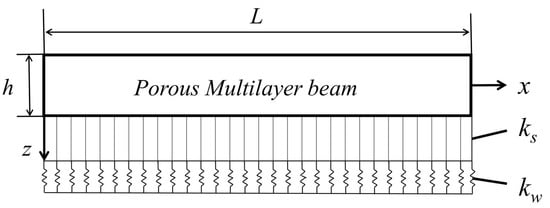
Figure 1.
FG porous multilayer beam resting on an elastic foundation.
Figure 2 considers three porosity distributions and GPL patterns. Because of disparate dispersion patterns, GPL patterns can be divided as A, B, and C, and the GPLs volume content is smoothly on the -axis. According to different porosity distributions, ’s peak values can be denoted as . Assuming three GPL patterns have the same total amount of GPLs will result in .
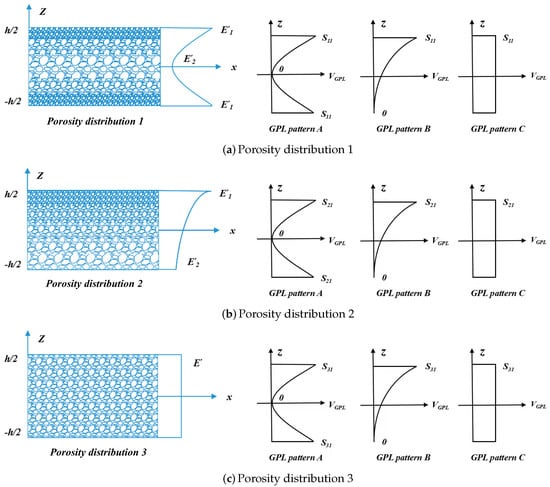
Figure 2.
GPL patterns and porosity distributions.
and are denoted as the maximum and minimum elastic moduli of the non-uniform porous beams without GPLs, respectively. In addition, represents the elastic moduli of the uniform porosity distribution beams.
The relationships of elastic moduli , mass density , and thermal expansion coefficient of FGP beams for three porosity distributions are given by the following formulas [25,33]
where
in which . Further, , , and are the maximum values of , , and , respectively. The porosity coefficient is referred to as
Based on the Gaussian Random Field (GRF) scheme, the mechanical property of closed-cell cellular solids is denoted by [34]
Using Equation (4), the coefficient of mass density is given by the following formula
Similarly, using the closed-cell GRF scheme, Poisson’s ratio is defined as [35]
where is Poisson’s ratio of pure non-porous matrix materials and
Due to the total masses being the same for the three porosity distributions, in Equation (2) can be defined as
in which M represents all porosity distributions, as shown in the following equation
According to the distribution patterns, the volume fraction of GPLs is denoted by
in which .
The relationship between the weight fraction of GPLs and the volume fraction of GPLs is given by
Based on Halpin–Tsai micromechanics model [36,37,38,39], the elastic moduli of the nanocomposites is defined as
where
where , , and are the average length, width, and thickness of GPLs. and represent the elastic moduli of the metal and GPLs.
By the following mixture rule, the mass density , Poisson’s ratio , and thermal expansion coefficient of the metal matrix reinforced by GPLs can be obtained as
in which , , , and are the mass density, Poisson’s ratio, thermal expansion coefficient, and volume fraction of the metals. Furthermore, , , , and are the corresponding properties of GPLs.
3. Formulations
3.1. Equations of Governing
Based on the Timoshenko beam theory, the displacement components are expressed as
in which U and W are the displacements of the x and z-axes, is expressed as the normal transverse rotation of the y-axis, and t represents time. On the basis of the linear stress-displacement relationships
The linear stress-strain constitutive relationships are as follows
where elastic elements and are denoted by
Using Hamilton’s principle, the considered problems can be expressed as
in which
stands for the variational symbol, T is the kinetic energy of the beam, V is made up of the axial force and thermally axial force due to uniform temperature change , and II consists of the strain energy of the beam and the elastic potential energy of the foundation.
The governing equations are given by applying Equation (20) to Hamilton’s principle in Equation (19), integrating through the beam thickness
Letting coefficients , , and from Equation (21) go to zero separately,
the force and moment are referred to
Applying Equations (17) and (18) to Equation (23),
where denotes the shear correction factor. The stiffness components, inertia terms, and thermally induced force and moment are defined as
in which .
By introducing dimensionless quantities
in which and are the value of and of the pure metal beams without any pores and nanofillers.
3.2. Solution Method
Based on the DQM rule, the displacement components , and , and the rth-order partial derivative is estimated in the following form [40,41]
in which are the values of , and is the Lagrange interpolating polynomial; is the weighting coefficient of the jth-order derivative [42]. N is the total number of grid points along the -axis. The distribution of the -axis is defined by a cosine pattern
By taking Equations (31) and (32) into Equations (29) and (30), the governing equations and boundary conditions are written as
clamped at both ends of .
hinged at both ends of , where and represent the first- and second-order weighting coefficients.
By combining the discretized governing equation, Equation (33), and boundary conditions, Equations (34) and (35), a series of dimensionless algebraic formulas has been obtained as
where is the unknown coefficient vector, and represent the stiffness matrix and the mass matrix, and and represent the geometric stiffness matrix.
For the beam under a time-varying axial excitation, the dimensionless axial force P is defined as
in which and represent the static and dynamic force components. By putting Equation (37) into Equation (36), we have
Under axial force and initial thermal loading, Equation (38) is a Mathieu–Hill-type equation, which is used to solve the problems of dynamic instability of the FGP beams. The boundary of the unstable region is obtained by Bolotin’s method [43]. According to the previous study, the solution with period 2 () has a larger principal unstable region than the solution with period , which is closer to the practical engineering significance. The solution to Equation (38) with period 2 uses the trigonometric form
where and are arbitrary constant vectors. Bolotin verified that the first-order approximation of accurately describes the boundary of the unstable region [43], so a homogeneous linear system of equations represented by and can be obtained by Bolotin’s method
For a given axial force, Equation (40) gives two critical excitation frequencies. The two curves in the figure of and are used to describe the principle unstable regions. When , it represents the origin of the principle unstable region, and represents the doubled fundamental frequency of the beam.
As for the thermal buckling problem, we form the equation by neglecting the inertia terms and making from Equation (38). Thus the critical buckling temperature rise can be obtained by solving the minimum positive eigenvalue of Equation (38)
Like thermal buckling, by setting and letting , the free frequency of the beam makes from the following formula
4. Discussion
The effects of various factors on thermal buckling, thermo-mechanical vibration, and dynamic instability of FGP beams are discussed. Copper is often chosen as a matrix material, the material parameters of which are = 130 GPa, = 8960 kg/m, = 0.34, and = 17 . The material and size parameters of GPLs as reinforced materials are = 1.5 m, = 2.5 m, = 1.5 nm, = 1.01 TPa, = 1062.5 kg/m, = 0.186, and = −3.75 [22,44,45,46].
4.1. Validation and Convergence Study
First, validation analysis is conducted. We adopt the degenerate forms of , , and to compare and validate with references [25,47]. Table 1 and Table 2 compare the fundamental frequency and critical buckling load with the calculation results in reference [25]. Figure 3 verifies the dynamic instability of Wu et al. [47]. In general, our results are consistent with the existing results.

Table 1.
The dimensionless fundamental frequency of C-C beams (porosity 1, GPL A, ).

Table 2.
The dimensionless critical buckling load of C-C beams (porosity 1, GPL A, ).
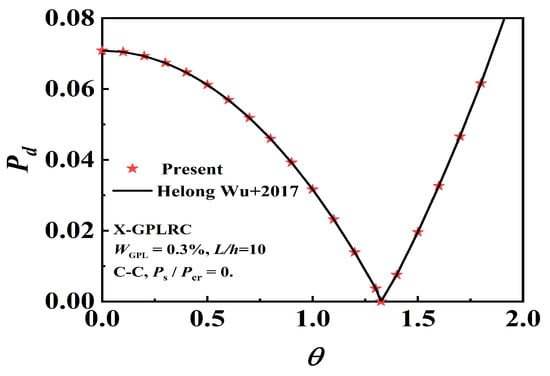
Figure 3.
Comparison of the dynamic instability.
Figure 4a,b separately show the convergence results of the critical buckling temperature rise and the dimensionless natural frequency under various conditions. When , their values gradually approach a certain amount. Table 3 and Table 4 present the effect of the porosity coefficient and the total number of layers n on the critical buckling temperature rise and dimensionless natural frequency by DQM and the two-step perturbation method (TSPM). It turns out that the error between them is within , and the accuracy and efficiency of the calculation results are verified again. Suppose n = 1000 is a continuous beam; it is found that a relative difference between n = 14 and n = 1000 is less than 1.5%. Considering the manufacturing process and manufacturing costs, n = 14 and are used in the following calculation. In addition, when n = 14 and , the results show the natural frequency and critical buckling temperature rise are both increasing as increases.
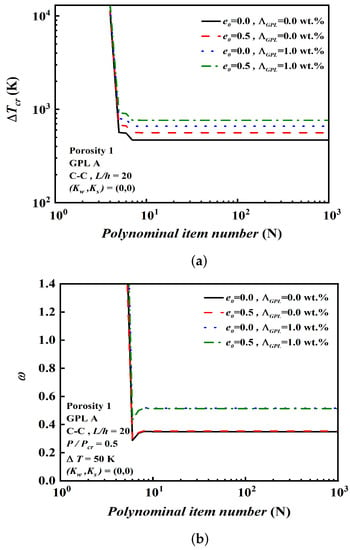
Figure 4.
Determine polynomial item number (N). (a) Determine polynomial item number (N) of the critical buckling temperature rise. (b) Determine polynomial item number (N) of the dimensionless fundamental frequency.

Table 3.
The critical buckling temperature rise of H-H beams (porosity 1, GPL A, , ).

Table 4.
The dimensionless fundamental frequency of H-H beams (porosity 1, GPL A, , , ).
4.2. Thermal Buckling
Figure 5 examines the effect of the foundation’s stiffness in critical buckling temperature rise. Where stands for no foundation, stands for Winkler foundation, and stands for Pasternak foundation. As observed, the critical buckling temperature increases as the foundation stiffness increases. The shearing layer stiffness contributes to more enhancement than the Winkler foundation stiffness .
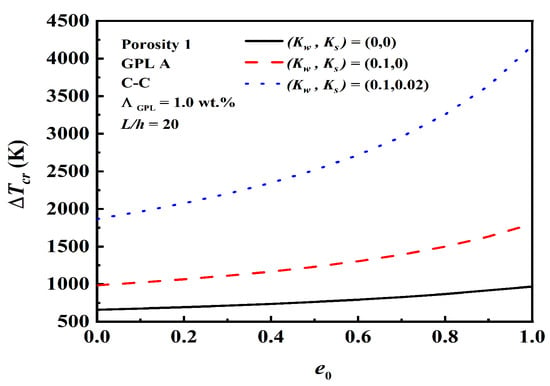
Figure 5.
Effect of foundation stiffness for critical buckling temperature rise.
Figure 6a,b show the critical buckling temperature rise and its percentage increment at GPL weight fraction . The results identify that symmetric GPL A with porosity 1 provides the best reinforcement, which takes the largest critical buckling temperature rise of the nine models. In addition, GPL C plays no role in the critical buckling temperature rise for the three porosity distributions.
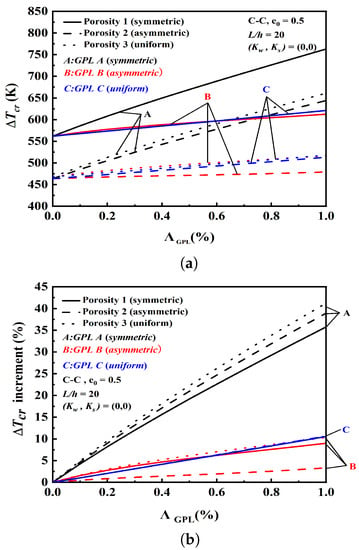
Figure 6.
Effect of GPL weight fraction on critical buckling temperature rise and its percentage. (a) Effect of GPL weight fraction on critical buckling temperature rise. (b) Effect of GPL weight fraction on the percentage of critical buckling temperature rise.
Table 5 illustrates the effect of boundary conditions and slenderness ratio on critical buckling temperature rise. As expected, the C-C beam with a smaller slenderness ratio has a maximum critical buckling temperature rise. With the increment of , the result shows a downward trend.

Table 5.
Effect of boundary conditions and slenderness ratio on critical buckling temperature rise. (Porosity 1, GPL A, , , ).
Figure 7 depicts the effect of geometry and size and on the critical buckling temperature rise. Larger and efficiently enhance the critical buckling temperature rise. Moreover, when reaches , the critical buckling temperature rise reaches a certain level, it will no longer increase any more, and as increases, the change in critical buckling temperature rise becomes less and less obvious.
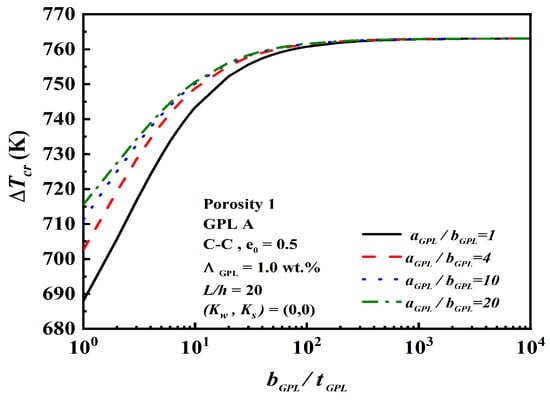
Figure 7.
Effect of and of GPL nanofillers on the critical buckling temperature rise.
4.3. Thermo-Mechanical Vibration
Figure 8 presents the effect of GPL weight fractions and normalized static axial force on the dimensionless fundamental frequency. The positive and negative values of indicate the compressive force and tensile forces. represents the critical buckling load at K. As observed, increasing leads to better mechanical behavior.
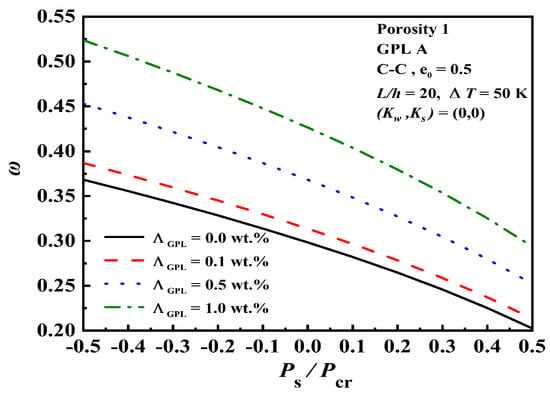
Figure 8.
Effect of GPL weight fractions and normalized static axial force on the dimensionless fundamental frequency.
Table 6 examines the effect of a normalized static axial force on the dimensionless fundamental frequency under porosity distributions and GPL patterns. Due to compression forces compressing the beam, the free vibration frequency decreases when the compression force increases. Like thermal buckling, GPL A with porosity 1 has the highest free-vibration frequency.

Table 6.
Effect of normalized static axial force on the dimensionless fundamental frequency under porosity distributions and GPL patterns (, = 1.0 wt.%, C-C, , , ).
The effects of normalized static axial force on the dimensionless fundamental frequency under initial thermal loading are shown in Figure 9. With the increment of initial thermal loading, the overall trend is downward. The changes in the dimensionless fundamental frequency were more apparent at larger values of .
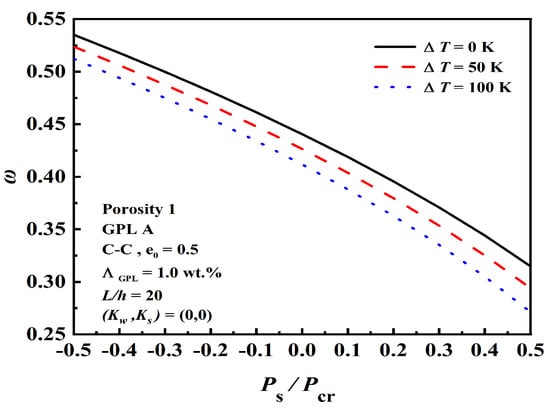
Figure 9.
Effect of normalized static axial force on the dimensionless fundamental frequency under initial thermal loading .
Figure 10 reveals the effects of normalized static axial force on the dimensionless fundamental frequency under various foundation stiffness. The dimensionless fundamental frequency increases as the foundation stiffness increases. Compared with compressive force, tensile force enhances the dimensionless fundamental frequency, which strengthens the stiffness of the beam.
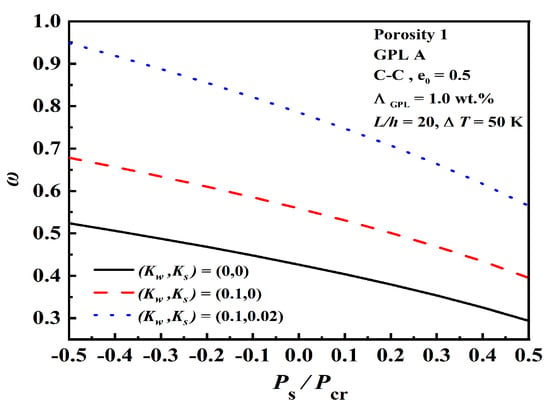
Figure 10.
Effect of normalized static axial force on the dimensionless fundamental frequency under various foundation stiffness.
4.4. Dynamic Instability
Figure 11 illustrates the effect of porosity distributions and GPL patterns on dynamic instability. Like thermal buckling and thermo-mechanical vibration, GPL A with porosity 1 has the largest origin and the narrowest unstable region among the nine models. Then, it is the best-enhanced model because the beam has a smaller pore distribution and more GPL in the top and bottom layers, which is where the normal bending stress is highest.
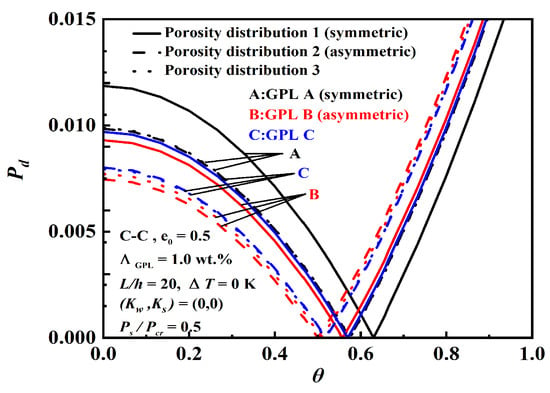
Figure 11.
Effect of porosity distributions and GPL patterns on dynamic instability.
Figure 12 depicts the effect of GPL weight fractions on dynamic instability. It is found that the origin becomes larger and the unstable region becomes narrower with the increment of , which indicates that the addition of GPL nanofillers effectively raises the stiffness of the beam.
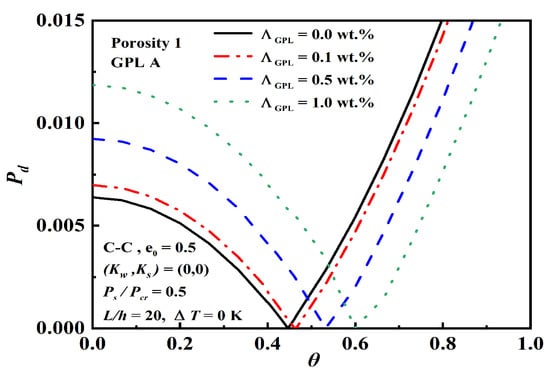
Figure 12.
Effect of GPL weight fractions on dynamic instability.
Figure 13 investigates the effect of the porosity coefficient on dynamic instability. As observed, the increment in , which means that the beam has larger pores and a denser distribution of pores, causes a reduction in beam stiffness, the origin becomes lower, and the unstable region becomes wider.
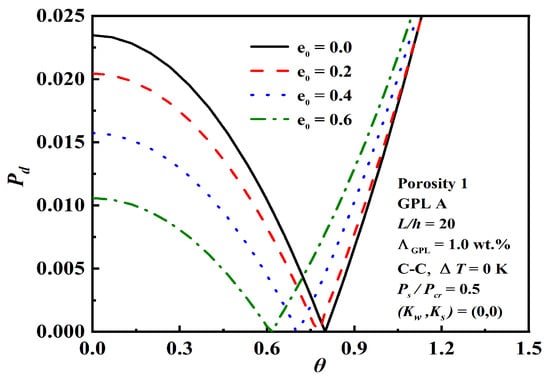
Figure 13.
Effect of the porosity coefficient on dynamic instability.
The effect of static axial compressive force and initial thermal loading on dynamic instability are shown in Figure 14 and Figure 15. Due to the change in and , the beam produces compression force, thus reducing the beam stiffness. As and decrease, the origin increases and the unstable region narrows. is able to achieve better structural stiffness, even more significantly than at the dynamic instability.
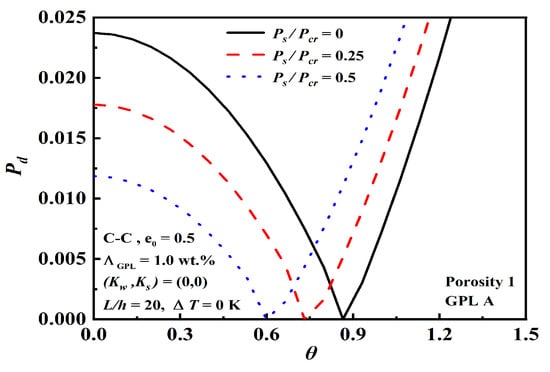
Figure 14.
Effect of static axial compressive force on dynamic instability.
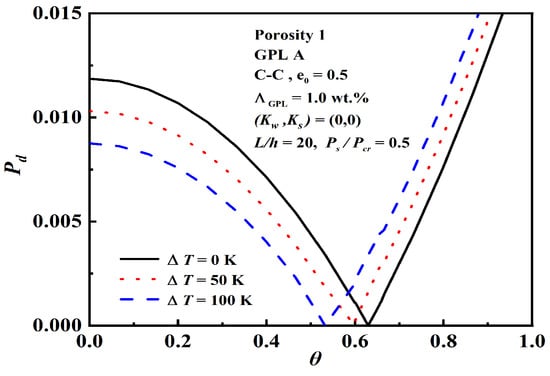
Figure 15.
Effect of initial thermal loading on dynamic instability.
The effect of the slenderness ratio , foundation stiffness, and boundary conditions on dynamic instability is demonstrated in Figure 16, Figure 17 and Figure 18. The results depict that the C-C beam with a smaller slenderness ratio on a Pasternak elastic foundation has a bigger origin and narrower unstable region, and the slenderness ratio and foundation stiffness have more obvious effects than the boundary conditions.
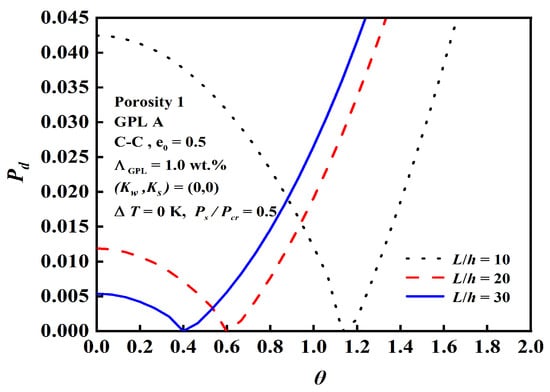
Figure 16.
Effect of the slenderness ratio on dynamic instability.
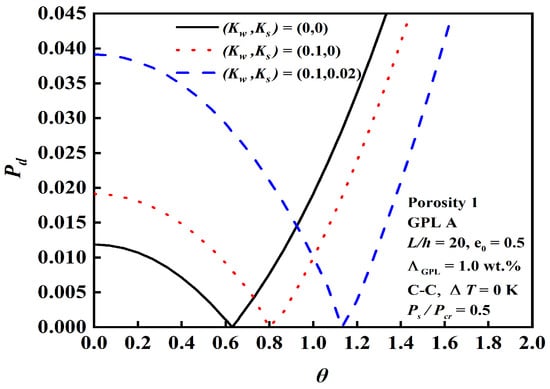
Figure 17.
Effect of the foundation stiffness on dynamic instability.
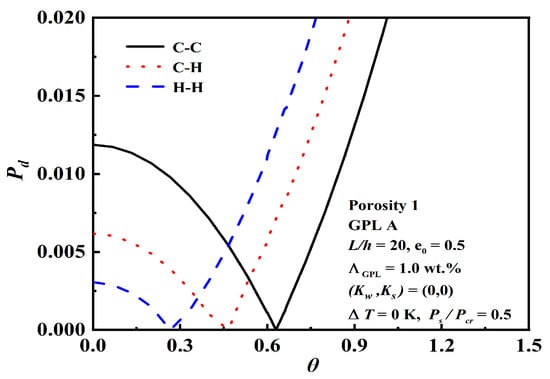
Figure 18.
Effect of the boundary conditions on dynamic instability.
Figure 19 examines the effect of the geometry and size and on dynamic instability. For a given , as increases, the change in the unstable region is insignificant, and the effect is tiny. For a given , the change in from 10 to has an obvious effect on the dynamic instability, but the effect of over is negligible. The results show that when the GPL contains less than a single graphene layer, it is better to reinforce the stiffness of the beam and enhance the mechanical behavior.
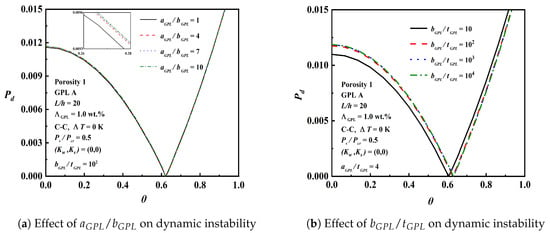
Figure 19.
Effect of and on dynamic instability.
5. Conclusions
The effect of GPL nanofillers on FGP composite beams under thermal environments, thermal buckling, thermo-mechanical vibration, and dynamic instability are investigated. Among them, weight fraction, normalized static axial force, porosity coefficient, dispersion pattern, boundary conditions, initial thermal loading, geometry and size, foundation stiffness, and slenderness ratio are studied. The following conclusions are obtained:
- •
- Porosity 1 reinforced by GPL A of the beam has the biggest value of critical buckling, temperature rise, dimensionless fundamental frequency, and the origin of dynamic instability. The non-uniform, symmetric porosity distribution and GPL pattern have the strongest enhancement.
- •
- The porosity coefficient has an important influence on thermal buckling, thermo-mechanical vibration, and dynamic instability. When the porosity coefficient grows, the origin of the dynamic instability shows a decreasing trend, but the dimensionless fundamental frequency and critical buckling temperature rise both increase.
- •
- The addition of GPL nanofillers can enhance the beam stiffness significantly, and the mechanical performance is enhanced with increases.
- •
- The values of thermo-mechanical vibration and dynamic instability decrease with normalized static axial force and initial thermal loading increase.
- •
- Winkler and Pasternak foundations both strengthen the stiffness of the beam. It is noted that shearing layer stiffness has a better enhancement effect than Winkler foundation stiffness.
Author Contributions
Conceptualization, J.Z.; Investigation, Y.L.; Supervision, L.L.; Writing—original draft, J.Z.; Writing—review and editing, L.L. All authors have read and agreed to the published version of the manuscript.
Funding
Supported by the National Natural Science Foundation of China (Nos. 11962026, 12002175, 12162027 and 62161045), Natural Science Foundation of Inner Mongolia (Nos. 2020MS01018, 2021MS01013), Fundamental Research Funds for the Inner Mongolia Normal University (Nos. 2022JBZD010, 2022JBXC013), and Graduate students’ Research & Innovation fund of Inner Mongolia Normal University (No. CXJJS22101).
Data Availability Statement
The data presented are available in this article.
Conflicts of Interest
The authors declare no conflict of interest.
References
- Vural, M.; Ravichandran, G. Dynamic response and energy dissipation characteristics of balsa wood: Experiment and analysis. Int. J. Solids Struct. 2003, 40, 2147–2170. [Google Scholar] [CrossRef]
- Avalle, M.; Belingardi, G.; Montanini, R. Characterization of polymeric structural foams under compressive impact loading by means of energy-absorption diagram. Int. J. Impact Eng. 2001, 25, 455–472. [Google Scholar] [CrossRef]
- Betts, C. Benefits of metal foams and developments in modelling techniquesto assess their materials behaviour: A review. Mater. Sci. Technol. 2012, 28, 129–143. [Google Scholar] [CrossRef]
- Mourad, C.; Suresh, G.A.; Ali, G.; Shridhar, Y. Modeling of filtration through multiple layers of dual scale fibrous porous media. Polym. Compos. 2006, 27, 570–581. [Google Scholar]
- Zeng, S.; Wang, K.; Wang, B.; Wu, J. Vibration analysis of piezoelectric sandwich nanobeam with flexoelectricity based on nonlocal strain gradient theory. Appl. Math. Mech. 2020, 41, 859–880. [Google Scholar] [CrossRef]
- Juergen, B.; Michael, S.; Matthew, S.; Marcus, A.W.; Monika, M.B.; Klint, A.R.; Theodore, F.B. Advanced carbon aerogels for energy applications. Energy Environ. Sci. Ees. 2011, 4, 656–667. [Google Scholar]
- Rabiei, A.; O’Neill, A.T. A study on processing of a composite metal foam via casting. Mater. Sci. Eng. 2005, 404, 159–164. [Google Scholar] [CrossRef]
- Nguyen, N.; Nguyen, T.; Nguyen, T.; Vo, T.P. A new two-variable shear deformation theory for bending, free vibration and buckling analysis of functionally graded porous beams. Compos. Struct. 2022, 282, 115095. [Google Scholar] [CrossRef]
- Akbaş, Ş.D. Forced vibration analysis of functionally graded porous deep beams. Compos. Struct. 2018, 186, 293–302. [Google Scholar] [CrossRef]
- Akbaş, Ş.D. Post-buckling responses of functionally graded beams with porosities. Steel Compos. Struct. 2017, 24, 579–589. [Google Scholar]
- Akbaş, Ş.D. Thermal Effects on the Vibration of Functionally Graded Deep Beams with Porosity. Int. J. Appl. Mech. 2017, 9, 556–569. [Google Scholar] [CrossRef]
- Farzad, E.; Mohadese, M. Transverse vibration analysis of rotating porous beam with functionally graded microstructure using the differential transform method. J. Braz. Soc. Mech. Sci. Eng. 2015, 37, 1435–1444. [Google Scholar]
- Yousef, S.A.R.; Azhar, G.H. Free vibration of functionally Euler-Bernoulli and Timoshenko graded porous beams using the transfer matrix method. KSCE J. Civ. Eng. 2017, 21, 792–806. [Google Scholar]
- Nuttawit, W.; Arisara, C. Flexural vibration of imperfect functionally graded beams based on Timoshenko beam theory: Chebyshev collocation method. Meccanica 2015, 50, 1331–1342. [Google Scholar]
- Chen, D.; Yang, J.; Kitipornchai, S. Elastic buckling and static bending of shear deformable functionally graded porous beam. Compos. Struct. 2015, 133, 54–61. [Google Scholar] [CrossRef]
- Chen, D.; Yang, J.; Kitipornchai, S. Free and forced vibrations of shear deformable functionally graded porous beams. Int. J. Mech. Sci. 2016, 108, 14–22. [Google Scholar] [CrossRef]
- Chen, D.; Kitipornchai, S.; Yang, J. Nonlinear free vibration of shear deformable sandwich beam with a functionally graded porous core. Thin-Walled Struct. 2016, 107, 39–48. [Google Scholar] [CrossRef]
- Hoa, L.K.; Hoan, P.V.; Hoai, B.T.T.; Chan, D.Q. Nonlinear Buckling and Postbuckling of ES-FG Porous Cylindrical Shells Under External Pressure. In Modern Mechanics and Applications; Springer: Singapore, 2022; pp. 743–754. [Google Scholar]
- Chan, D.Q.; Hoan, P.V.; Trung, N.T.; Hoa, L.K.; Huan, D.T. Nonlinear buckling and post-buckling of imperfect FG porous sandwich cylindrical panels subjected to axial loading under various boundary conditions. Acta Mech. 2021, 232, 1163–1179. [Google Scholar] [CrossRef]
- Li, Z.; Wang, L.; Li, Y.; Feng, Y.; Feng, W. Carbon-based functional nanomaterials: Preparation, properties and applications. Compos. Sci. Technol. 2019, 179, 10–40. [Google Scholar] [CrossRef]
- Gong, L.; Young, R.J.; Kinloch, I.A.; Riaz, I.; Jalil, R.; Novoselov, K.S. Optimizing the reinforcement of polymer-based nanocomposites by graphene. ACS Nano 2012, 6, 2086–2095. [Google Scholar] [CrossRef]
- Sumio, I. Helical microtubules of graphitic carbon. Nature 1991, 354, 56–58. [Google Scholar]
- Novoselov, K.S.; Geim, A.K.; Morozov, S.V.; Jiang, D.; Zhang, Y.; Dubonos, S.V.; Grigorieva, I.V.; Firsov, A.A. Electric Field Effect in Atomically Thin Carbon Films. Science 2004, 306, 666–669. [Google Scholar] [CrossRef] [PubMed]
- Chen, D.; Yang, J.; Kitipornchai, S. Nonlinear vibration and postbuckling of functionally graded graphene reinforced porous nanocomposite beams. Compos. Sci. Technol. 2017, 142, 235–245. [Google Scholar] [CrossRef]
- Sritawat, K.; Da, C.; Jie, Y. Free vibration and elastic buckling of functionally graded porous beams reinforced by graphene platelets. Mater. Des. 2017, 116, 656–665. [Google Scholar]
- Yas, M.; Rahimi, S. Thermal buckling analysis of porous functionally graded nanocomposite beams reinforced by graphene platelets using Generalized differential quadrature method. Aerosp. Sci. Technol. 2020, 107, 106261. [Google Scholar] [CrossRef]
- Yas, M.; Rahimi, S. Thermal vibration of functionally graded porous nanocomposite beams reinforced by graphene platelets. Appl. Math. Mech. Engl. Ed. 2020, 41, 1209–1226. [Google Scholar] [CrossRef]
- Yang, J.; Chen, D.; Kitipornchai, S. Buckling and free vibration analyses of functionally graded graphene reinforced porous nanocomposite plates based on Chebyshev-Ritz method. Compos. Struct. 2018, 193, 281–294. [Google Scholar] [CrossRef]
- Teng, M.W.; Wang, Y.Q. Nonlinear forced vibration of simply supported functionally graded porous nanocomposite thin plates reinforced with graphene platelets. Thin-Walled Struct. 2021, 164, 107799. [Google Scholar] [CrossRef]
- Dong, Y.H.; He, L.W.; Wang, L.; Li, Y.H.; Yang, J. Buckling of spinning functionally graded graphene reinforced porous nanocomposite cylindrical shells: An analytical study. Aerosp. Sci. Technol. 2018, 82–83, 466–478. [Google Scholar] [CrossRef]
- Zhou, Z.; Ni, Y.; Tong, Z.; Zhu, S.; Sun, J.; Xu, X. Accurate nonlinear buckling analysis of functionally graded porous graphene platelet reinforced composite cylindrical shells. Int. J. Mech. Sci. 2019, 151, 537–550. [Google Scholar] [CrossRef]
- Yang, Z.; Wu, H.; Yang, J.; Liu, A.; Safaei, B.; Lv, J.; Fu, J. Nonlinear forced vibration and dynamic buckling of FG graphene-reinforced porous arches under impulsive loading. Thin-Walled Struct. 2022, 181, 110059. [Google Scholar] [CrossRef]
- Lakes, R.S. Cellular solid structures with unbounded thermal expansion. J. Mater. Sci. Lett. 2004, 15, 475–477. [Google Scholar] [CrossRef]
- Roberts, A.P.; Garboczi, E.J. Elastic moduli of model random three-dimensional closed-cell cellular solids. Acta Mater. 2001, 49, 189–197. [Google Scholar] [CrossRef]
- Roberts, A.P.; Garboczi, E.J. Computation of the Linear Elastic Properties of Random Porous Materials with a Wide Variety of Microstructure. Proc. Math. Phys. Eng. Sci. 2002, 458, 1033–1054. [Google Scholar] [CrossRef]
- Rafiee, M.A.; Rafiee, J.; Wang, Z.; Song, H.; Yu, Z.; Koratkar, N. Enhanced mechanical properties of nanocomposites at low graphene content. ACS Nano 2009, 3, 3884–3890. [Google Scholar] [CrossRef] [PubMed]
- Shokrieh, M.; Esmkhani, M.; Shokrieh, Z.; Zhao, Z. Stiffness prediction of graphene nanoplatelet/epoxy nanocomposites by a combined molecular dynamics - micromechanics method. Comput. Mater. Sci. 2014, 92, 444–450. [Google Scholar] [CrossRef]
- Affdl, J.C.H.; Kardos, J.L. The Halpin-Tsai equations: A review. Polym. Eng. Sci. 1976, 16, 344–352. [Google Scholar] [CrossRef]
- Guzmán De Villoria, R.; Miravete, A. Mechanical model to evaluate the effect of the dispersion in nanocomposites. Acta Mater. 2007, 55, 3025–3031. [Google Scholar] [CrossRef]
- Shu, C. Differential Quadrature and Its Application in Engineering; Springer Science and Business Media: London, UK, 2012. [Google Scholar]
- Wu, H.; Kitipornchai, S.; Yang, J. Thermo-electro-mechanical postbuckling of piezoelectric FG-CNTRC beams with geometric imperfections. Smart Mater. Struct. 2016, 25, 95022–95035. [Google Scholar] [CrossRef]
- Bert, C.W.; Wang, X.W.; Striz, A.G. Differential quadrature for static and free vibration analyses of anisotropic plates. Int. J. Solids Struct. 1993, 30, 1737–1744. [Google Scholar] [CrossRef]
- Bolotin, V. The Dynamic Stability of Elastic Systems; Holden-Day: San Francisco, CA, USA, 1962. [Google Scholar]
- Tjong, S.C. Recent progress in the development and properties of novel metal matrix nanocomposites reinforced with carbon nanotubes and graphene nanosheets. Mater. Sci. Eng. Rep. 2013, 74, 281–350. [Google Scholar] [CrossRef]
- Bakshi, S.; Lahiri, D.; Agarwal, A. Carbon nanotube reinforced metal matrix composites—A review. Int. Mater. Rev. 2010, 50, 41–64. [Google Scholar] [CrossRef]
- Jagannadham, K. Thermal Conductivity of Copper-Graphene Composite Films Synthesized by Electrochemical Deposition with Exfoliated Graphene Platelets. Metall. Mater. Trans. Process. Metall. Mater. Process. Sci. 2011, 43, 316–324. [Google Scholar] [CrossRef]
- Wu, H.; Yang, J.; Kitipornchai, S. Dynamic instability of functionally graded multilayer graphene nanocomposite beams in thermal environment. Compos. Struct. 2017, 162, 244–254. [Google Scholar] [CrossRef]
Publisher’s Note: MDPI stays neutral with regard to jurisdictional claims in published maps and institutional affiliations. |
© 2022 by the authors. Licensee MDPI, Basel, Switzerland. This article is an open access article distributed under the terms and conditions of the Creative Commons Attribution (CC BY) license (https://creativecommons.org/licenses/by/4.0/).